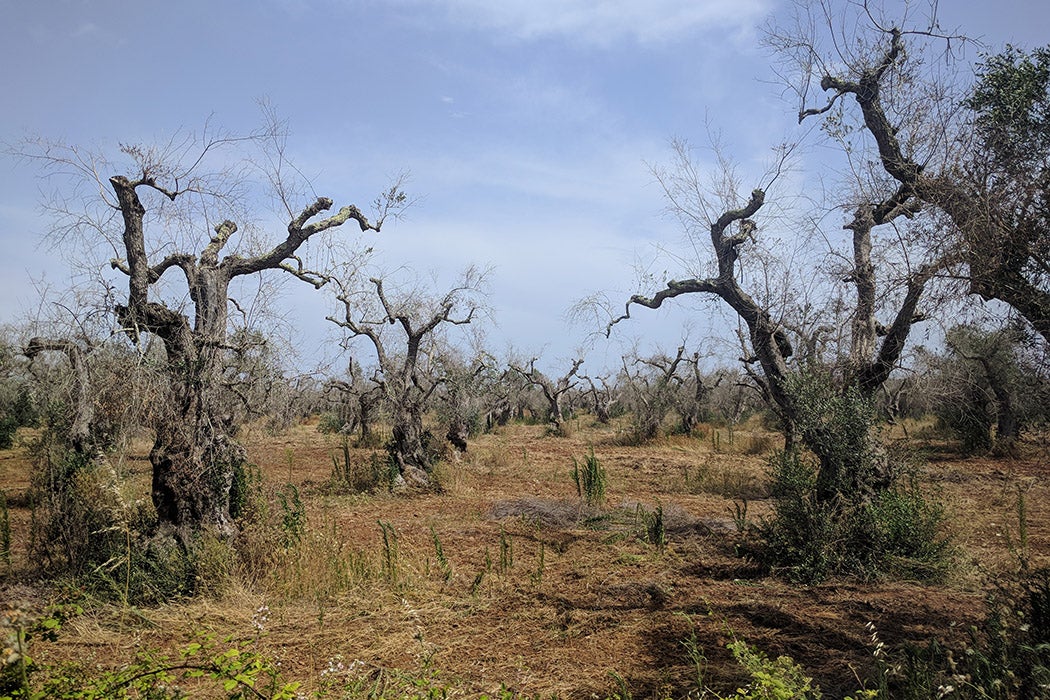The bacterium Xylella fastidiosa is sometimes described as one of the most dangerous plant pathogens in the world. Inadvertently transported by sap-sucking insects such as leafhoppers and spittlebugs, it can attack more than 500 species, including crops, ornamentals, and trees including oak and elm.
Many of the bacterium’s hosts are asymptomatic. Some only show symptoms after months or even years. Epidemics can, however, spread rapidly and devastatingly. Symptoms include leaf necrosis, twig dieback, fruit yield decline, and, ultimately, death. Essentially, X. fastidiosa obstructs xylem, a plant’s water-transporting tissue, choking the plant to death.
Most economic losses due to the bacterium’s effects occur in Brazil and the United States. In 2013, the pauca subspecies of X. fastidiosa was discovered in olive trees in the Apulia region of southern Italy for the first time. The bacterium was traced to imported Costa Rican coffee plants. The import of coffee plants has since been banned by the European Union under quarantine rules.
Typical efforts to contain X. fastidosa include vector (insect) control, the introduction of resistant cultivars, and the destruction of affected plants. Removing ancient olive trees, however, is a culturally fraught enterprise throughout the Mediterranean basin.
Cultivation of olive trees dates back at least seven thousand years, and the tree has long been exploited by humans for its wood, fruit, and the oil extracted from that fruit. Italy, Spain, and Greece together account for 95 percent of European olive oil production. In addition to being edible, olive oil has been burned for light and used for medicinal and ritual/religious purposes. Olives are also deeply intertwined with the three monotheistic religions that arose in the Mediterranean region: Judaism, Christianity, and Islam. The reluctance of southern Italian farmers—who, for instance, plant trees to mark births—and local politicians to go along with containment efforts, or even allow scientists to monitor the disease, has helped the spread of the disease in Italy.
Olive Quick Decline Syndrome, as the bacterium’s manifestation is olive trees is called, is thus a cause of serious concern. Scientists Keven Schneider, Woke van der Werf, Marina Cendoya, and their co-authors consider potential impacts of the syndrome on the olive tree and its adjacent industries.
“The majority of orchards were found to be within climatically suitable territory,” the write. “Even under slow disease spread and the ability to replant with resistant cultivars, projections of future ecumenic impact in affected countries run into the billions of Euros.”
The worst-case scenario is that “production ceases after orchards die off.” That’s an estimated $5.6 billion economic loss for Italy alone. Since X. fastidiosa also hits other important crops such as grapes, cherries, and almonds, the authors note that the impact in Europe could “far exceed” their olive-only evaluations. (An additional factor is the effect on tourism, since the ubiquitous olive tree is a major point of attraction in the southern Italian landscape.)
Of course, olive cultivation has spread well beyond the Mediterranean. Olives are now farmed in North and South America, Australia, New Zealand, and South Africa. 80 percent of the world’s olive harvest is turned into oil; 20 percent is destined for table olive use. (Fresh or raw olives are too bitter to be palatable so they are cured or fermented.)
Weekly Newsletter
Olive are slow-growing, long-lived trees. An olive orchard is thus a future-oriented proposition centuries in the making. Resistant olive (and other affected plant) cultivars and vector control could well result in better-case scenarios. Such technical solutions will need to be combined with social, cultural, economic, and political components in situations awash in conspiracy theories, mistrust of science, and the reactionary populism that thrives in such conditions.
One example of a devastating plant-pathogen fate averted is shown in the response to the Phylloxera wine blight. Introduced from the New World, this pest nearly vanquished Old World vineyards in the nineteenth century. The grafting of naturally-resistant American rootstock to Old World vines helped saved the day. Not that the literal American roots of Grand Crus reduces the price of them today.
Hopefully, something similar will rescue the wonder that is the olive.







